Knee Pain From Elliptical: Reasons & Efficient Solutions
Author:
Unlock your full potential by engaging with our experts and community! Have questions about your fitness journey or looking for expert advice on weightlifting techniques? Don’t hesitate — leave a comment below and Ernesto Mendez will provide a personalized answer and insights to help you reach your goals.
Torokhtiy is reader-supported. Some links are affiliate links, and we may earn a commission at no extra cost to you. See our disclosure page for details.
Suffering from discomfort or even a sharp ache in your knees when exercising on the elliptical machine? Do you want to know its reason: whether you’re doing something wrong, or maybe you need to check your health? Or are there some solutions to mitigate those pain and fully enjoy your workout?
Many questions occur to you and all of them should be solved asap. In this article, we’ll shed light on the key reasons for knee pain from the elliptical and provide you with effective ways to eliminate this issue once and for all.
Despite being a low-impact workout, an elliptical machine can result in knee stiffness. Improper adjustment, wrong exercise technique, or prior injuries can be the main reasons for knee pain from elliptical. Rely on experienced coaches and doctors to resolve the issue and alleviate the knees hurt after elliptical training.
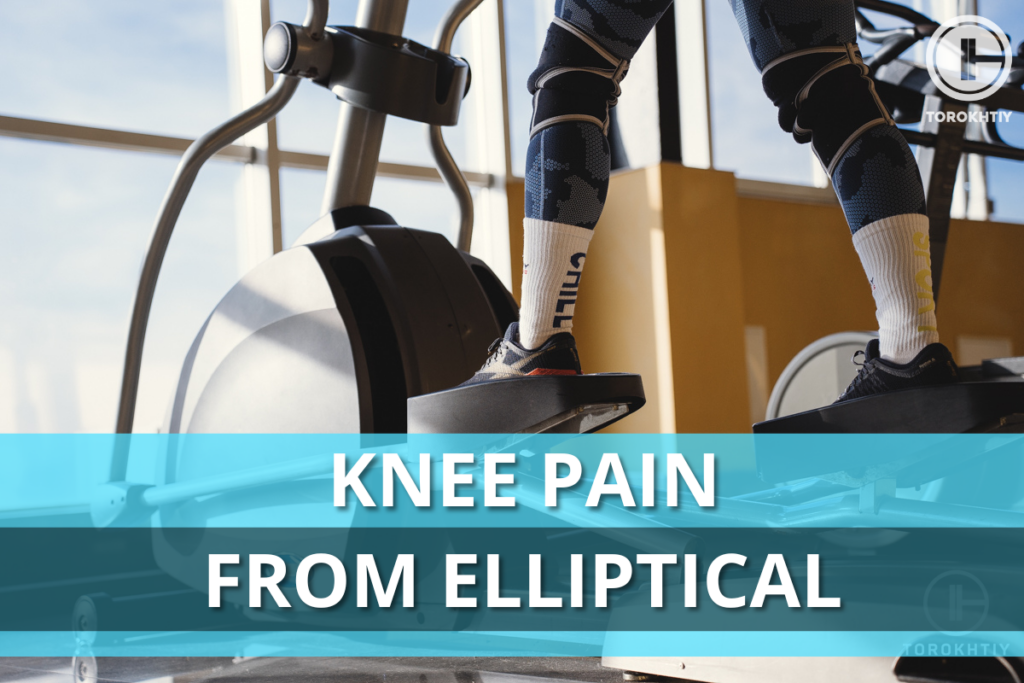
Intro to Knee Pain From Elliptical: What Is It and How Does It Work?
Before finding the answer to the question that matters to us that is why knees hurt on the elliptical, let’s define the key peculiarities of the elliptical machine and its features, as well as outline the advantages of this gym tool and how you can tone up your body with its help.
An elliptical trainer, known also as an elliptical machine, trainer, glider machine, or a cross trainer, is a tool you can use for running, walking, and climbing sessions. Although, you won’t get the tension on your knees and ligaments equal to those while running or climbing in real life.
This equipment refers to cardio machines, you can train the upper and lower body with its help by keeping your joints in safety and minimizing injury to the maximum.
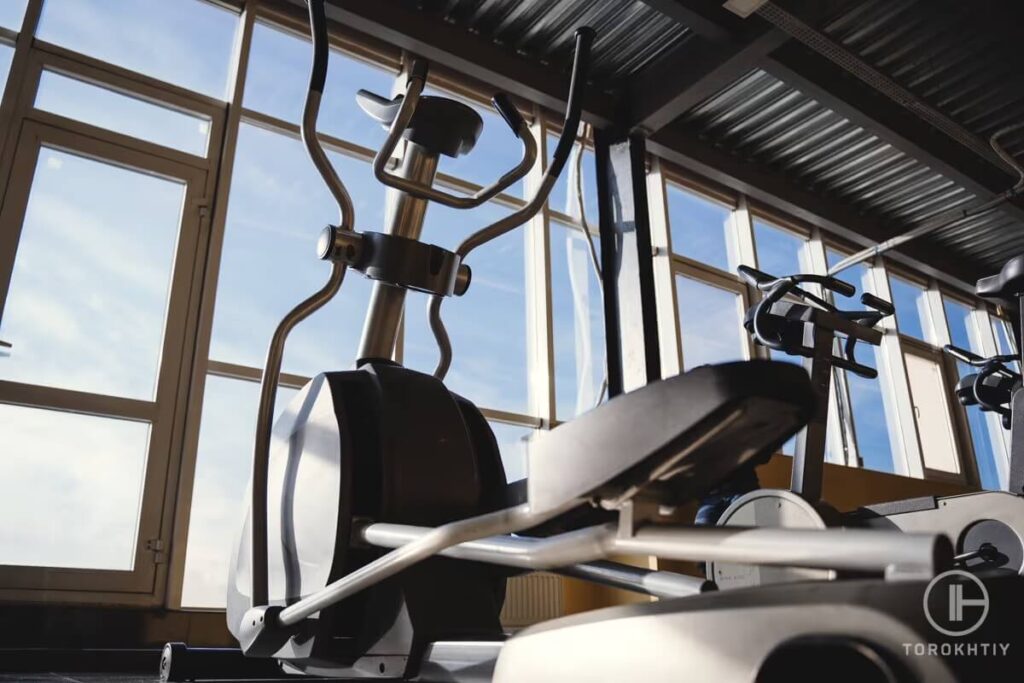
However, there are some disputes about elliptical machine benefits and training efficiency, and whether there’s a minor impact on the knees. As most fitness equipment manufacturers claim an elliptical machine is a full-body training equipment with low-impact features, so even it can fit the newbies in fitness.
There’s apparently no risk to overtrain on the elliptical like with a treadmill or stair climber. Additionally, a beginner can start to train slowly by gradually increasing the tempo.
The first drawback you can notice during the workout on the elliptical machine is that it can occur to be quite boring training: you remain in the same plain position for some time without being able to make any adjustments.
This makes your time endless and monotonous, so the elliptical machine drops behind other gym cardio workouts such as spinning and stationary bike classes.
What Muscles Can You Work Out On The Elliptical Machine?
By following the right technique, you can train the glute, quadriceps, adductor, abductor, hamstrings muscles, calves, back, biceps, triceps, and chest. Although, arms are involved minimally: you activate arms just to hold the swinging handles optionally for extra balance.
At the same time, if you won’t hold them while training, you won’t be able to involve the chest and back muscles as much as when skipping using the bars.
The most focus comes to the lower body: almost all the load is allocated to the glutes during the stride-rotation movement. Additionally, you’ll succeed in strengthening your hamstrings, quads, and ankles due to the constant pressure of the feet on the pedals. By the way, this motion can help minimize lower extremities joint injuries, and enhance your coordination and balance.
4 Causes of Knee Pain When Using Elliptical
Many athletes, both amateurs and professionals, may experience some stiffness in their knees during or after training on the elliptical machine. You may ask ‘Is elliptical good for knees?’. There can be various reasons for the problem: equipment overuse, lack of recovery time, too intensive training, pre-existing knee issues, wrong technique, etc.
In this section, we’ll outline the major causes of knee and joint pain while working out on the elliptical trainer.
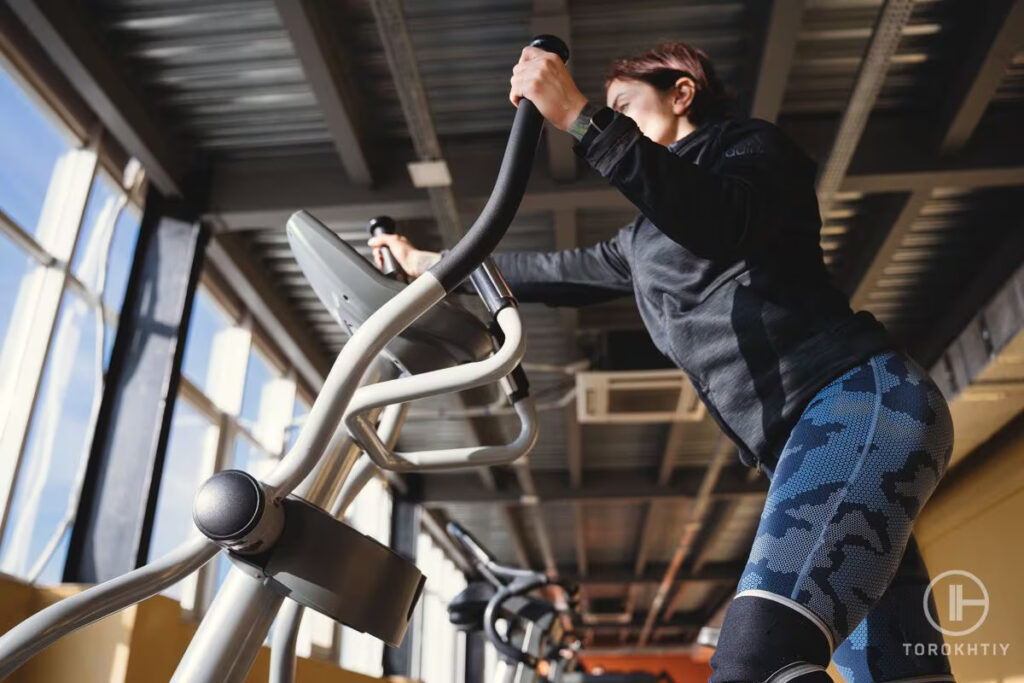
1. Keeping Bad Posture While Exercising
If you lean forward when training on the elliptical machine, you cause unnecessary tension on the knees. So, if moving this way for a long time, you’ll inevitably suffer from knee and other lower extremities joint pain because all the pressure and shock absorption function go to a specific part of the body.
2. Overtraining the Joints
Frequency of use can create increased pain in the knees from the elliptical machine. This point refers most to beginners who believe that if they set up higher resistance or if they do the elliptical machine for longer periods of time than their body can tolerate, they’ll achieve greater results and better results.
But it’s quite the opposite: instead of getting a well-balanced workout, you are overusing your body tolerance affecting any progression made and increasing the pain of the different joints.
Another aspect that starters neglect is not giving themselves enough time to recover without realizing that it can lead to problems with ligaments and knees. Or the opposite situation also can occur: an athlete doesn’t give enough effort, so they exercise without feeling tired.
This motion won’t strengthen muscles that surround the knees, thus they’ll fail to protect joints from other further loads. As a result, the whole workout is in vain.
Follow us!

Free!
Get a 2-week Weightlifting Program as a bonus for the subscription to kickstart your training plan!

Free!
3. Body Aging Changes
With age, your knees and joints become weaker and the bone density lowers that increases the risk of injuries even when doing some rapid movements. Although, this process is natural and we can do nothing against it, just keep an active lifestyle, and strengthen our knees with the help of moderate exercises by cutting down the intensity of training.
Our weight and height also can influence the pain level while exercising on the elliptical. The heavier you are, the more discomfort you may feel during running the elliptical. The reason is the extra weight in your knees should hold besides counteracting the machine resistance.
4. Previous Injuries
If you had some knee current or previous knee injuries or any past knee surgeries and you haven’t recovered fully, it’s obvious you will feel extra tension, pain and/or discomfort in the knee area when working out on the elliptical trainer.
Some examples of the most common knee injuries are patellar dislocations, ligamentous injuries (sprain) like an anterior cruciate ligament (ACL), a meniscus tear, and/ or tendon tears or strains.
So, if you want to start with the elliptical and you were injured and you feel you are not fully recovered, visit your doctor or physical therapist who will help you recover fully and explain the recovery workout plan to improve and mitigate knee symptoms.
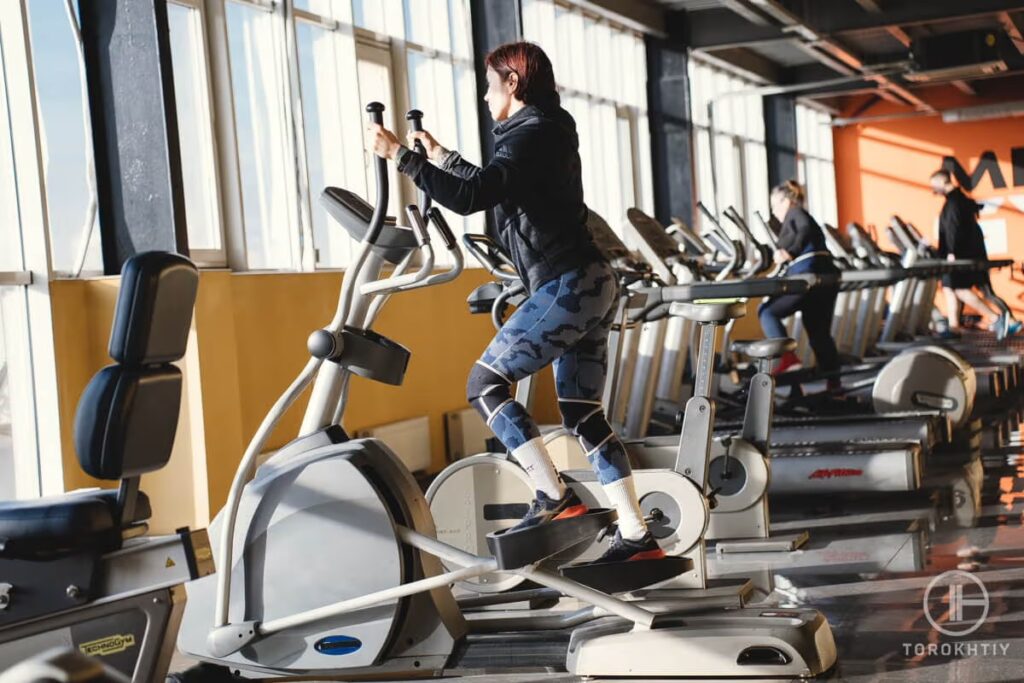
5 Best Practices For Protecting Your Knees On The Elliptical Machine
Nevertheless, if you did face the problem of knee pain from elliptical, you should solve this issue immediately in order not to aggravate the situation. The following steps will help you to mitigate the discomfort and help you to keep on exercising.
1. Start Each Workout By Warming Up
A proper warm-up before any type of training is important to evade injuries. You can increase blood circulation and oxygen intake by loosening the muscles that bring an opportunity to resist tension during exercise and avoid occasional strains.
Do some stretching to get prepared for the main workout, particularly focus on warming up exercises targeting the muscles you’ll involve while training on the elliptical.
2. Finish Your Workout With A Cool-Down Exercise
Once you finish your training, do cooling-down stretching exercises to relax the muscles and reduce aches and muscle tension. It’s also helpful to soothe the joints and relax the whole body the same way yoga classes would influence.
3. Use A Knee Sleeve Or Brace
Before the first training on this equipment check how to protect your knees on the elliptical. Wearing a knee bandage will provide you with additional support and cushioning. When exercising on the elliptical with the knee sleeve or brace, you feel a little tightness by bringing some kind of control while running the elliptical with a bit higher resistance.
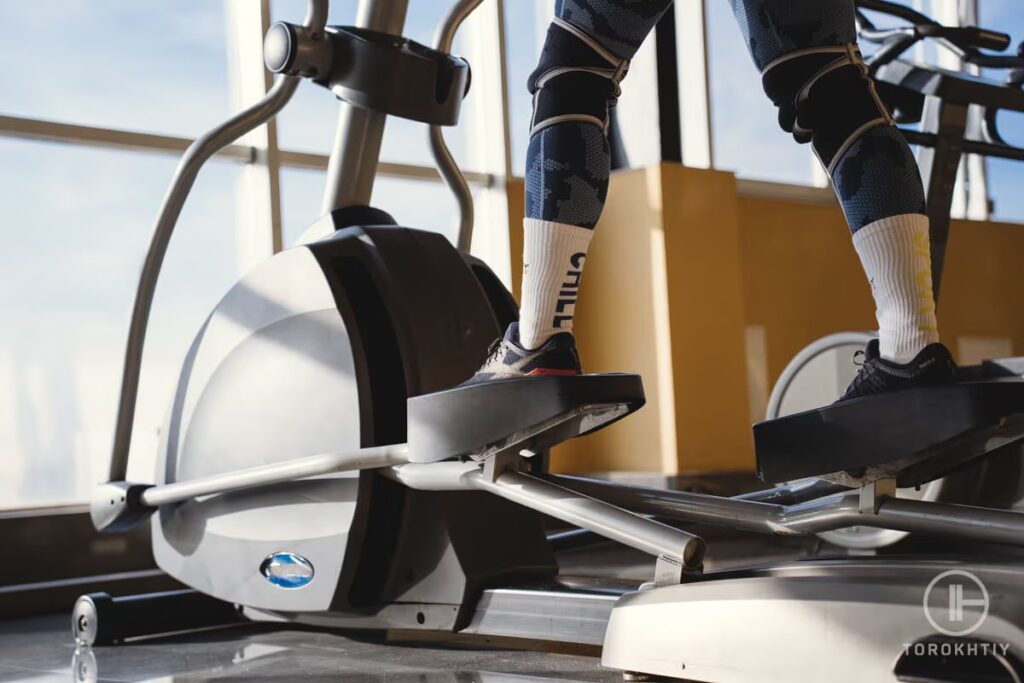
4. Don’t Knock Yourself Out Too Much
Although an elliptical workout is low-impact and you suppose you won’t get enough load, don’t push yourself too much. If you want to minimize knee injuries you’d better progress towards intensity, resistance, and workout training duration.
Always start with slow motion and just after warming your legs enough, move to the next intense grade with no pain by adding speed and resistance.
5. Consider Your Nutrition Plan
Proper nutrition will benefit your training and boost your energy. The way you eat can significantly influence your performance: nutritional and healthy meals will facilitate the build-up of energy, strength, and muscle-building.
Some foods that help cartilage health are fish, nuts, berries, green tea, and dairy. Omega-3 fatty acids, collagen, glucosamine, chondroitin, and Methylsulfonnylmethane (MSM) are supplements that directly are associated with knee health and longevity.
2 Modifications And Alternatives For Knee-Friendly Cardio Workouts
If you’re searching for a worthy substitution for the elliptical machine training that won’t damage your knees, then you’ll find a great number of other cardio training that will improve your knee condition.
1. Swimming as an Alternative Cardio Workout for the Elliptical
Swimming is a great option for people with knee issues. Besides you can burn a lot of calories quickly and train the major muscles, swimming reduces stress on your knees and even can help you to soothe them.
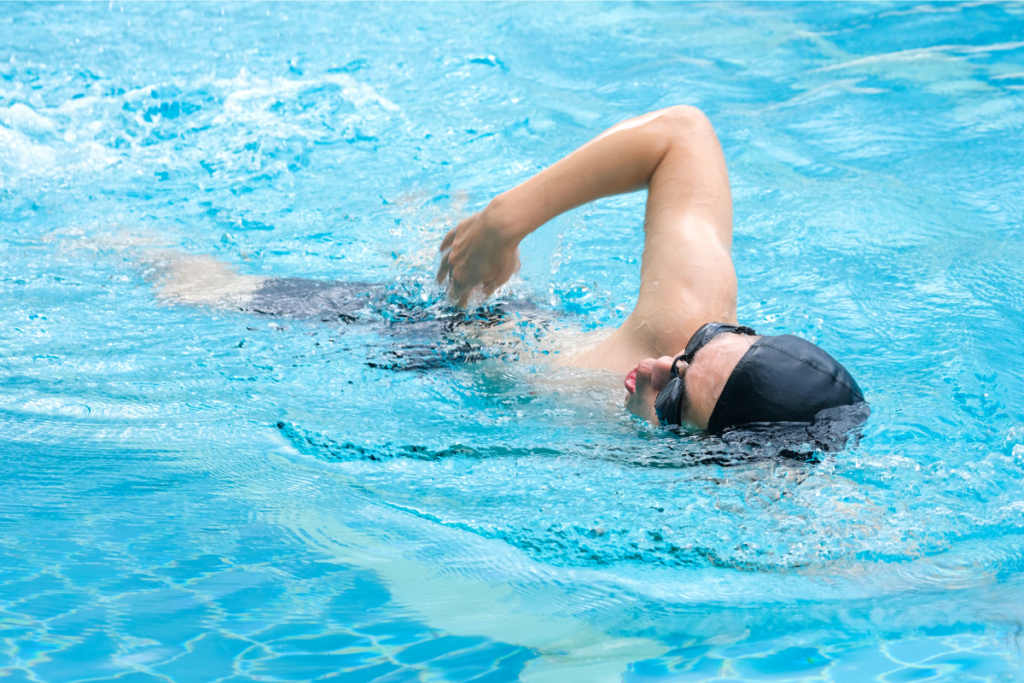
An extra variant is joining a water aerobics class, where you can work out your knees and joints carefully by jogging in place or doing resistance training with weights.
2. Strengthening Low-Impact Knee Exercises to Minimize Injuries
Other exercises that help you to build strength and flexibility in your knees while minimizing the risk of injury and pain in your knees are squats, leg press, knee extension machines, lunges, and calf raises.
Body-weight exercises are becoming popular today since there’s no need to use a gym machine or weights for resistance, just your own weight. Generally, aerobics training will bring you mild to moderate resistance levels with no sharp aches in the knees.
You can try walking every day, the stationary bike training, rower, ski erg, Cal bike, or even an underdeck treadmill.
FAQ
Is Elliptical Bad For Knees?
Since the elliptical makes you be in a fixed position for a long time, there’s a high possibility that you will strain your knees with the wrong body positioning while working out. Your muscles can’t work on the full range of motion because your feet are steadily on the foot platforms.
There’s a chance to place unnecessary tension on the ligaments and pull on the patella resulting in sharp pain in the knee area.
So, the answer to the question “Is the elliptical machine bad for knees?” The answer is NO, but inappropriate training and use can be detrimental when using the elliptical machine.
Does Elliptical Strengthen Knees?
Considering the above-mentioned statements, the positive influence of the elliptical machine can be in the case when you perform every exercise correctly with proper technique and moderate pace. So, the short answer to the question “Does elliptical strengthen knees?” is “yes, especially without following the proper exercise performance”.
How To Protect Your Knees On An Elliptical?
As we already mentioned the most effective solution to mitigate knee pain after elliptical is to do warming up before the training on the elliptical and wear a knee band for better support and motion control. Also, don’t switch to higher speeds too early, you should prepare your body and knees, particularly for higher-intensity workouts.
Conclusion
Still not sure about exercising on the elliptical for bad knees, and whether to skip such training or try it to improve your body condition? But, if you’re suffering from discomfort or acute pain in the knees and joints, you’d better restrain yourself from this type of workout.
But, if you can’t refuse this equipment, consider our recommendations on knee pain from the elliptical.
If any question occurs on how to arrange your workout and which measures to perform if the pain is still present after the workout, feel free to write us directly below the article. In any case, follow your feelings and body reaction during and after the workout to find the best training option for you.
Also read:
- Knee Pain After Working Out
- Knee Pain From Leg Press
- Knee Pain From Treadmill
- Knee Pain When Squatting
- Knee Pain From Lunges
- 5mm vs 7mm Knee Sleeves
References:
- Movement direction impacts knee joint kinematics during elliptical exercise at varying incline angles // NIH: https://pubmed.ncbi.nlm.nih.gov /33640619/
- Factors associated with subjective knee joint stiffness in people with knee osteoarthritis: A systematic review // NIH: https://pubmed.ncbi.nlm.nih.gov /36572505/
- Anterior cruciate ligament injuries: anatomy, physiology, biomechanics, and management // NIH: https://pubmed.ncbi.nlm.nih.gov /22695402/
- Braces and orthoses for treating osteoarthritis of the knee // NIH: https://pubmed.ncbi.nlm.nih.gov /25773267/
- 10 Nutritious Foods For Rebuilding Cartilage & Promoting Healthy Joints // Mobilitydeck: https://mobilitydeck.com/ foods-for-rebuilding-cartilage/
- Photos made by Torokhtiy Media Team; photo by Ake Ngiamsanguan, Canva.
Why Trust Us?
With over 20 years in Olympic weightlifting, strength training, nutrition coaching, and general fitness our team does its best to provide the audience with ultimate support and meet the needs and requirements of advanced athletes and professional lifters, as well as people who strive to open new opportunities and develop their physical capabilities with us.
By trusting the recommendations of our certified experts in coaching, nutrition, and sports training programming, as well as scientific consultants, and physiotherapists, we provide you with thorough, well-considered, and scientifically proven content. All the information given in the articles concerning workout programming, separate exercises, and athletic performance, in general, is based on verified data.
The product testing process is described in more detail here.
Author: Ernesto Mendez
Orthopedic Clinical Specialist
Best Results: Snatch – 208 kg,
C&J – 240 kg
Dr. Ernesto Mendez is a licensed physical therapist, a board Orthopedic Clinical Specialist (OCS) and founder of Movement 4 Wellness Physical Therapy, LLC. He earned his degree from Thomas Jefferson University. He is also an Olympic weightlifting coach (USAW L1) and Functional Fitness Level 1 Trainer. His experience includes the areas of pain management, movement analysis, injury recovery, surgical rehab, corrective exercise, and athletic, military, and occupational performance. Dr Mendez is passionate about Olympic weightlifting and fitness. Ernesto Mendez is responsible for designing multiple training programs, writing blog articles, posting daily weightlifting content, doing live weightlifting and mobility seminars.



Still have questions after reading our article? Unlock your full potential by engaging with our experts and community! Don’t hesitate — leave a comment below and Ernesto Mendez will provide a personalized answer and insights to help you reach your goals.